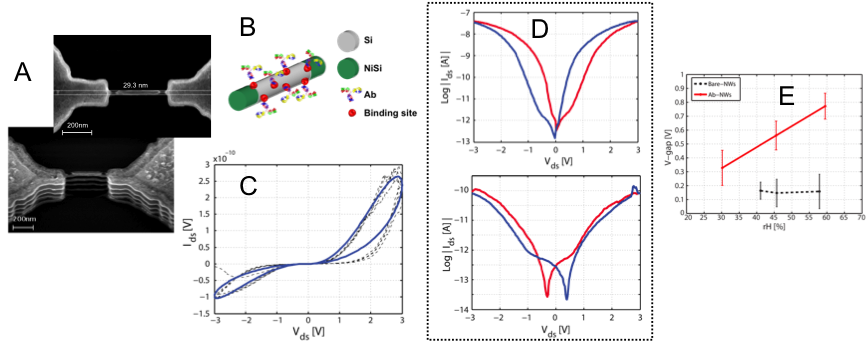Go to
Francesca Puppo
A new biosensing approach: memristive silicon nanowires for biomolecule detection
Thanks to their unique properties, including diameters similar to proteins, high surface-to-volume ratio and tunable electron transport properties due to quantum confinement effects, nanowires (NW) have great potential for the fabrication of nanosensors that can provide fast, low-cost, and high-throughput analysis of biological processes. At present, these 1-D nanostructures have been shown to provide a sensing modality for label-free and direct electrical readout when the NW is used as a semiconducting channel of a chemiresistor or field-effect transistor. NW biosensor methods reported in the literature are based upon direct measurement of the change in DC conductance of the nanowire due to the attachment of a molecule of interest to the functionalized surface.
The present project focuses on the investigation of a new biosensing approach based on memristive silicon nanowires. The proposed NW biosensor combines the molecular selectivity of immunoassays and the sensitivity power of a novel electronic detection based on a voltage property discovered in our memristive NWs.

Figure 1. (A) SEM images of the fabricated memristive NWs; (B) schematic representation of the NW functionalization with antibodies (Ab) and antigen (Ag) uptake; (C) comparison between the simulated memristor theory (dashed curve) and the acquired characteristic from a fabricated wire (blue curve); (D) increasing voltage gap between forward and backward current minima after functionalization with biomolecules (lower image); (E) Mean voltage gap as function of the humidity calculated on 20 wires prior to (black line) and after (red line) functionalization. NW sensitivity to humidity if functionalized with biomolecules with respect to the constant and close to zero behavior of bare NWs.
Due to the nano-scale of the fabricated geometries (Fig. 1A), fabricated SiNW devices have been discovered to show hysteretic properties imputable to memristors1 (Fig. 1C). Changing electrical properties of the hysteretic behavior (Fig. 1D) with the amount of molecules attracted on the nanowire surface have been found to enable the sensing of molecular species at their very low concentrations1,2,3 (fM). Moreover, the role of the air humidity has been identified as one important factor strongly affecting the nanowire biosensor performances in dry environment1 (Fig. 1E).
These findings open the way to the study of a completely new bio-detection mechanism with the particular aim of targeting breast cancer biomarkers at the very early stage of the tumor disease, when their amount in the human organism is very low and still below the detection limit of the state-of-the-art diagnostic tools.
1 F. Puppo, A. Dave, M.-A. Doucey, D. Sacchetto, C. Baj-Rossi, Y. Leblebici, S. Carrara, and G. De Micheli, IEEE Transactions on NanoBioscience – submitted.
2 S. Carrara, D. Sacchetto, M.-A. Doucey, G. De Micheli, and Y. Leblebici, Sens. Actuators B: Chem. 2012, 171-172, 449–457.
3 D. Sacchetto, M.-A. Doucey, G. De Micheli, Y. Leblebici and S. Carrara, BioNanoScience 2011, 1(1-2), 1-3
About the speaker:
 Francesca Puppo received the B.Sc. degree in Biomedical Engineering and the M.Sc. degree, passed with cum laude, in Bioengineering, both from the University of Genoa (Italy), in 2008 and 2011 respectively. She carried out her Master thesis at the Integrated System Laboratory (LSI) of EPFL (Switzerland) in collaboration with the Department of Electrical Engineering and Biophysics (DIBE) of the University of Genoa (Italy). She worked on the design and the fabrication of a CNTFET-based biosensor. She also interned at LSI for a five-month project based on the study of Silicon Nanowire based biosensors. Currently she is working as a PhD student in Microsystems and Microelectronics in the Integrated System Laboratory (LSI) of EPFL, under the supervision of Prof. Giovanni De Micheli and Dr. Sandro Carrara. Her research focuses on the design and fabrication of silicon nano-wire based devices for biosensing applications.
Francesca Puppo received the B.Sc. degree in Biomedical Engineering and the M.Sc. degree, passed with cum laude, in Bioengineering, both from the University of Genoa (Italy), in 2008 and 2011 respectively. She carried out her Master thesis at the Integrated System Laboratory (LSI) of EPFL (Switzerland) in collaboration with the Department of Electrical Engineering and Biophysics (DIBE) of the University of Genoa (Italy). She worked on the design and the fabrication of a CNTFET-based biosensor. She also interned at LSI for a five-month project based on the study of Silicon Nanowire based biosensors. Currently she is working as a PhD student in Microsystems and Microelectronics in the Integrated System Laboratory (LSI) of EPFL, under the supervision of Prof. Giovanni De Micheli and Dr. Sandro Carrara. Her research focuses on the design and fabrication of silicon nano-wire based devices for biosensing applications.
Secondary navigation
- EPFL Workshop on Logic Synthesis and Emerging Technologies
- Luca Amaru
- Luca Benini
- Giovanni De Micheli
- Srini Devadas
- Antun Domic
- Rolf Drechsler
- Pierre-Emmanuel Gaillardon
- Jie-Hong Roland Jiang
- Akash Kumar
- Shahar Kvatinsky
- Yusuf Leblebici
- Shin-ichi Minato
- Alan Mishchenko
- Vijaykrishnan Narayanan
- Ian O'Connor
- Andre Inacio Reis
- Martin Roetteler
- Julien Ryckaert
- Mathias Soeken
- Christof Teuscher
- Zhiru Zhang
- Symposium on Emerging Trends in Computing
- Layout synthesis: A golden DA topic
- EPFL Workshop on Logic Synthesis & Verification
- Luca Amaru
- Luca Benini
- Robert Brayton
- Maciej Ciesielski
- Valentina Ciriani
- Jovanka Ciric-Vujkovic
- Jason Cong
- Jordi Cortadella
- Giovanni De Micheli
- Antun Domic
- Rolf Drechsler
- Henri Fraisse
- Paolo Ienne
- Viktor Kuncak
- Enrico Macii
- Igor Markov
- Steven M. Nowick
- Tsutomu Sasao
- Alena Simalatsar
- Leon Stok
- Dirk Stroobandt
- Tiziano Villa
- Symposium on Emerging Trends in Electronics
- Raul Camposano
- Anantha Chandrakasan
- Jo De Boeck
- Gerhard Fettweis
- Steve Furber
- Philippe Magarshack
- Takayasu Sakurai
- Alberto Sangiovanni-Vincentelli
- Ken Shepard
- VENUE
- Panel on Circuits in Emerging Nanotechnologies
- Panel on Emerging Methods of Computing
- Panel on The Role of Universities in the Emerging ICT World
- Panel on Design Challenges Ahead
- Panel on Alternative Use of Silicon
- Nano-Bio Technologies for Lab-on-Chip
- Functionality-Enhanced Devices Workshop
- More Moore: Designing Ultra-Complex System-on-Chips
- Design Technologies for a New Era
- Nanotechnology for Health
- Secure Systems Design
- Surface Treatments and Biochip Sensors
- Security/Privacy of IMDs
- Nanosystem Design and Variability
- Past Events Archive
